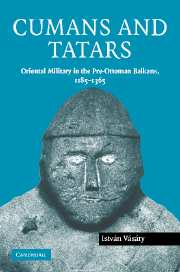Book contents
- Frontmatter
- Contents
- Preface
- 1 Introduction
- 2 Cumans and the Second Bulgarian Empire
- 3 Cumans in the Balkans before the Tatar conquest, 1241
- 4 The first period of Tatar influence in the Balkans, 1242–1282
- 5 The heyday of Tatar influence in the Balkans, 1280–1301
- 6 Cumans and Tatars on the Serbian scene
- 7 Cumans in Byzantine service after the Tatar conquest, 1242–1333
- 8 The Tatars fade away from Bulgaria and Byzantium, 1320–1354
- 9 The emergence of two Romanian principalities in Cumania, 1330, 1364
- Conclusion
- Appendix 1 List of geographical names
- Appendix 2 Chronological table of dynasties
- Appendix 3 Maps
- List of abbreviations
- Bibliography
- Index
8 - The Tatars fade away from Bulgaria and Byzantium, 1320–1354
Published online by Cambridge University Press: 29 July 2009
- Frontmatter
- Contents
- Preface
- 1 Introduction
- 2 Cumans and the Second Bulgarian Empire
- 3 Cumans in the Balkans before the Tatar conquest, 1241
- 4 The first period of Tatar influence in the Balkans, 1242–1282
- 5 The heyday of Tatar influence in the Balkans, 1280–1301
- 6 Cumans and Tatars on the Serbian scene
- 7 Cumans in Byzantine service after the Tatar conquest, 1242–1333
- 8 The Tatars fade away from Bulgaria and Byzantium, 1320–1354
- 9 The emergence of two Romanian principalities in Cumania, 1330, 1364
- Conclusion
- Appendix 1 List of geographical names
- Appendix 2 Chronological table of dynasties
- Appendix 3 Maps
- List of abbreviations
- Bibliography
- Index
Summary
TATAR RAIDS, 1320–1321
As we saw in Chapter 5, the fall of Nogay and his son Čeke in 1300–1 did not mean the end of Tatar rule in Dobrudja and Bessarabia. Tatar power simply shifted from Nogay (a local chief) to Toqta (the khan in the centre). Yet this shift from local to central power was enough to loosen the dependence on the Tatars of the Balkanic territories south of the Danube. Tatar power did not disappear from the region; it was just that the burdens of that power were lifted. Bulgaria, Serbia and Byzantium did not have to face an imminent and head-on collision with the Tatars of the Golden Horde. Rather, during Teodor Svetoslav's reign (1300–22), the Bulgarian–Tatar relationship was well balanced. The Bulgars recognised the Tatar suzerainty and paid tribute to the Tatars, and in return, the towns of the Danube and Dniestr deltas and possibly Bessarabia were under their actual control. Bulgar dependence on the Tatars must have been much less than during Nogay's time, prior to 1300.
After the withdrawal of the Catalans from Macedonia in 1311, Andronikos II maintained friendly relations with the Serbian and Bulgarian rulers, both of whom were related to him by marital connections. His daughter Simonis was married to the Serbian Milutin, and his granddaughter Theodora to the Bulgarian Teodor Svetoslav. Thus, in the first twenty years of the fourteenth century, relative peace prevailed in Byzantine–Bulgarian–Serbian relations.
- Type
- Chapter
- Information
- Cumans and TatarsOriental Military in the Pre-Ottoman Balkans, 1185–1365, pp. 122 - 133Publisher: Cambridge University PressPrint publication year: 2005

